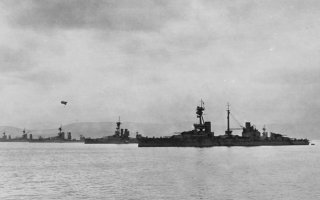HMS Agincourt was a True “Gun Boat” in Every Sense of the Word
To date, five Royal Navy warships have been named HMS Agincourt in honor of the Battle of Agincourt of 1415. However, it was the World War I battleship that surely would have impressed King Henry V, the victor in the famous battle–for she had the largest number of main-caliber guns ever carried on a warship.
To date, five Royal Navy warships have been named HMS Agincourt in honor of the Battle of Agincourt of 1415. However, it was the World War I battleship that surely would have impressed King Henry V, the victor in the famous battle–for she had the largest number of main-caliber guns ever carried on a warship. Yet despite her capabilities and armament, the battleship was never truly put to the test in combat. While she participated in the Battle of Jutland, it has been reported she never scored a hit on a German warship during the First World War.
What is also notable about this British dreadnought battleship is that she wasn’t originally intended for the Royal Navy. Instead, she was ordered by the Brazilian government in 1911 for service with its navy during the South American naval arms race and laid down as Rio de Janerio. However, when the South American nation’s rubber boom collapsed and its relations with Argentina improved, the vessel was resold to the Ottoman Empire and renamed Sultân Osmân I Evvel in honor of Sultan Osman I, the empire’s founder.
She was about halfway to completion and with clouds of war looming on the horizon, work actually slowed on the warship. In a twist of fate, when the First World War broke out, the ship was seized for use by the Royal Navy on the orders of First Lord of the Admiralty Winston Churchill. That act actually caused serious resentment with the Ottoman Empire’s government as the payment for the Sultân Osmân I Evvel and another battleship, Reşadiye, had already been made.
Churchill’s other motive was to ensure that the warships weren’t to be used by Germany or German allies–and it has been debated for more than 100 years whether the seizure played any role in the Ottoman government’s decision to join with Germany and Austria, and to declare war on Britain and the Entente Cordiale. In the end, Reşadiye was renamed HMS Erin, while Sultân Osmân I Evvel became HMS Agincourt.
What was also unique about Agincourt is that she proved to be the only member of her class, which is typically rare in a warship’s procurement and especially so at the time. Why the warship was named for the decisive English victory over the French in October 1415 isn’t clear either, but the ship was commissioned as such in August 1915.
She was massive even by dreadnought standards and was 671 feet 6 inches in length and 89 feet in beam, and with seven turrets that included fourteen 12-inch (304.8mm) BL Mk XIII guns as her main battery. The weight of the guns came at a price, resulting in lessened armor protection, which ranged from 229 mm thickness at the belt to just 64 mm maximum on deck. The barbettes were protected by up to 229 mm while her turrets had 305 mm or armor. Still, the battleship could make headway at 22 knots on full in ideal conditions. She was powered by 22 water-tube boilers with four Parsons steam turbines, which provided 34,000 horsepower to the four shafts.
She was actually considered roomy and provided excellent internal arrangements of living and working quarters. There were some notable quirks that the ship’s crew had to deal with–including the fact that all the instruction plates were initially in Portuguese. However, those were later changed and the ship became more crowded after 1917 when the size of the crew increased from 1,115 to 1,267 officers and men.
HMS Agincourt survived the war, and afterward the British attempted to resell the proven veteran back to the Brazilian government, which unsurprisingly, declined the offer. Instead, she was placed in reserve status and was officially decommissioned in April of 1921. In accordance with the then newly-drafted Washington Naval Treaty, HMS Argincourt was scrapped.
Peter Suciu is a Michigan-based writer who has contributed to more than four dozen magazines, newspapers, and websites. He regularly writes about military small arms and is the author of several books on military headgear including A Gallery of Military Headdress, which is available on Amazon.com.
Image: Wikimedia Commons

